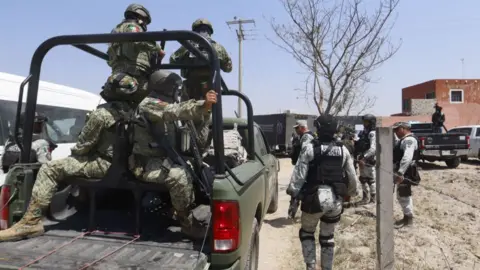Recently, an alarming discovery was made in central Mexico, where six severed heads were found on a road. This shocking incident occurred in an area that is not typically known for its association with cartel violence, sparking heightened public concern and media attention. The discovery was made early on a Tuesday morning on a route that connects the generally peaceful Mexican states of Puebla and Tlaxcala.
Local law enforcement agencies have not released any information regarding the motive behind these gruesome killings. Additionally, they have not disclosed which of the numerous criminal organizations operating throughout Mexico could be responsible for this act of violence. As investigations proceed, local media have reported that a blanket was discovered at the scene, featuring a message that appears to be a warning directed at rival gangs. This message reportedly bears the signature of a group identified as “La Barredora,” which translates to “The Sweeper.”
The name “La Barredora” is already linked to a relatively obscure criminal organization involved in activities in the western state of Guerrero; however, it remains uncertain whether they are indeed behind these particular attacks or if there are other motives at play. The local prosecutor’s office has confirmed that the heads found in Tlaxcala belonged to male victims and has commenced an investigation into the motives and circumstances surrounding the incident, working in collaboration with news agency AFP.
In addition to the ongoing concerns about drug trafficking, the region is also plagued by rampant fuel smuggling, sometimes referred to as “huachicolea.” This illicit activity generates billions of dollars a year for the criminal groups involved. As of now, federal authorities have yet to issue any statements concerning the recent killings. This grim occurrence takes place amidst a broader crackdown initiated by President Claudia Sheinbaum’s administration against the trafficking of fentanyl.
It is important to note that Puebla and Tlaxcala are not typically associated with the extreme levels of violence that define other regions of Mexico, particularly in areas known for significant cartel activity. For example, just last June, the bodies of twenty individuals—four of whom were decapitated—were found in Sinaloa, a state infamous for gang violence. Furthermore, the violence extends to tragic incidents such as the shooting that claimed the lives of seven young Mexicans during a religious celebration at a Catholic Church in Guanajuato earlier this year.
As violence stemming from cartel rivalries continues to rise in Mexico, the country has witnessed a staggering number of fatalities, with hundreds of thousands killed and tens of thousands more missing since the government initiated military operations against gangs starting in 2006. The pervasive culture of violence and fear has progressively taken a toll on various segments of the population, stirring apprehensions among local residents and authorities alike.
The implications of such acts of brutality extend beyond mere statistics; they serve to underpin the complex and often perilous situation in which communities find themselves in Mexico today. As the investigation progresses into the motives and perpetrators behind the heinous act of displaying severed heads, it’s clear that the ongoing battle against cartel violence will require not merely law enforcement, but a broad societal response capable of addressing the roots of the problem. This tragic event has underscored the urgency of effectively combating the spike in violence and ensuring the safety and security of the Mexican people.












